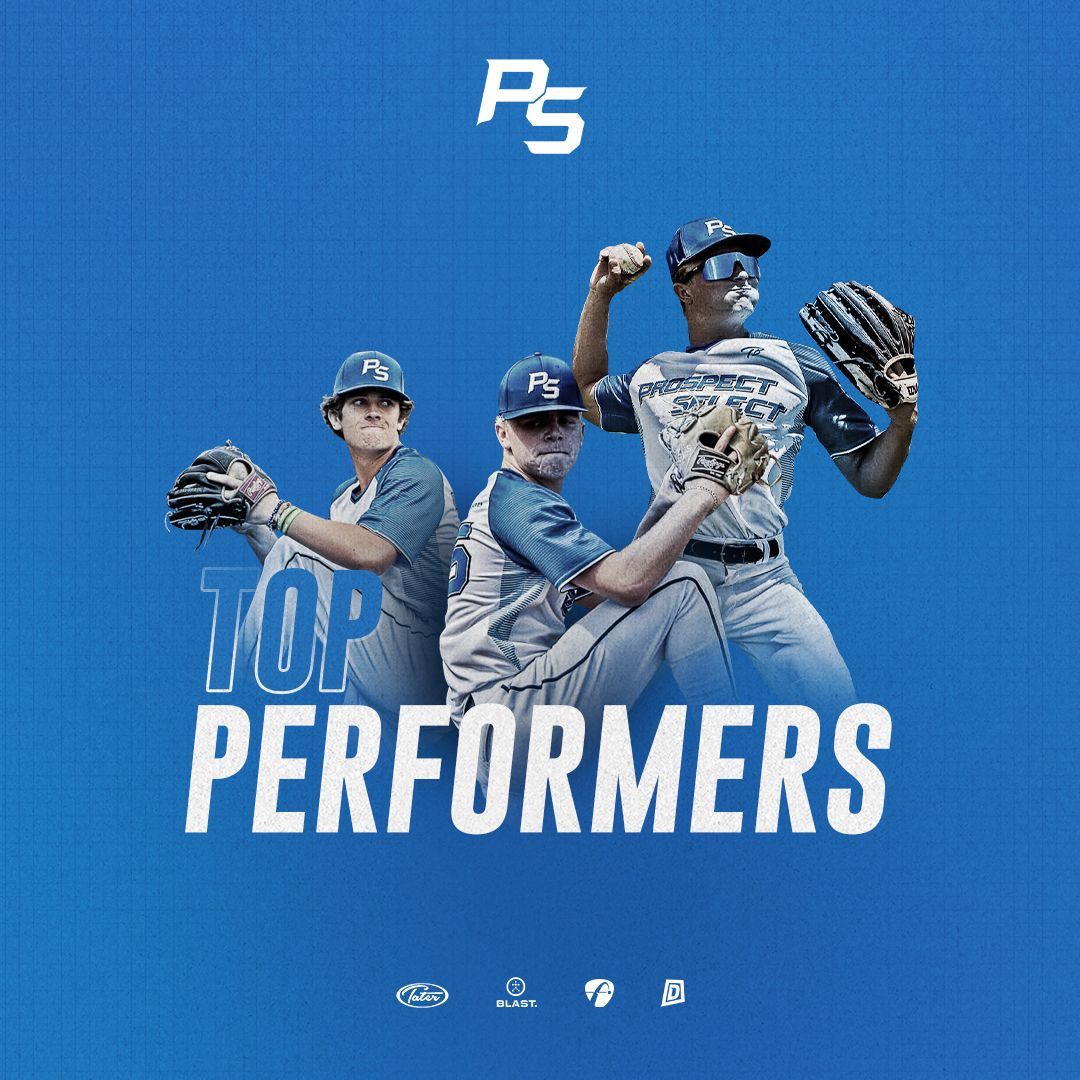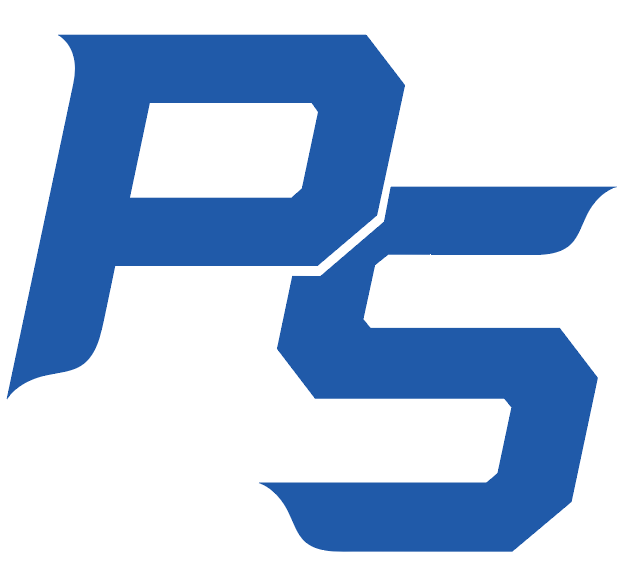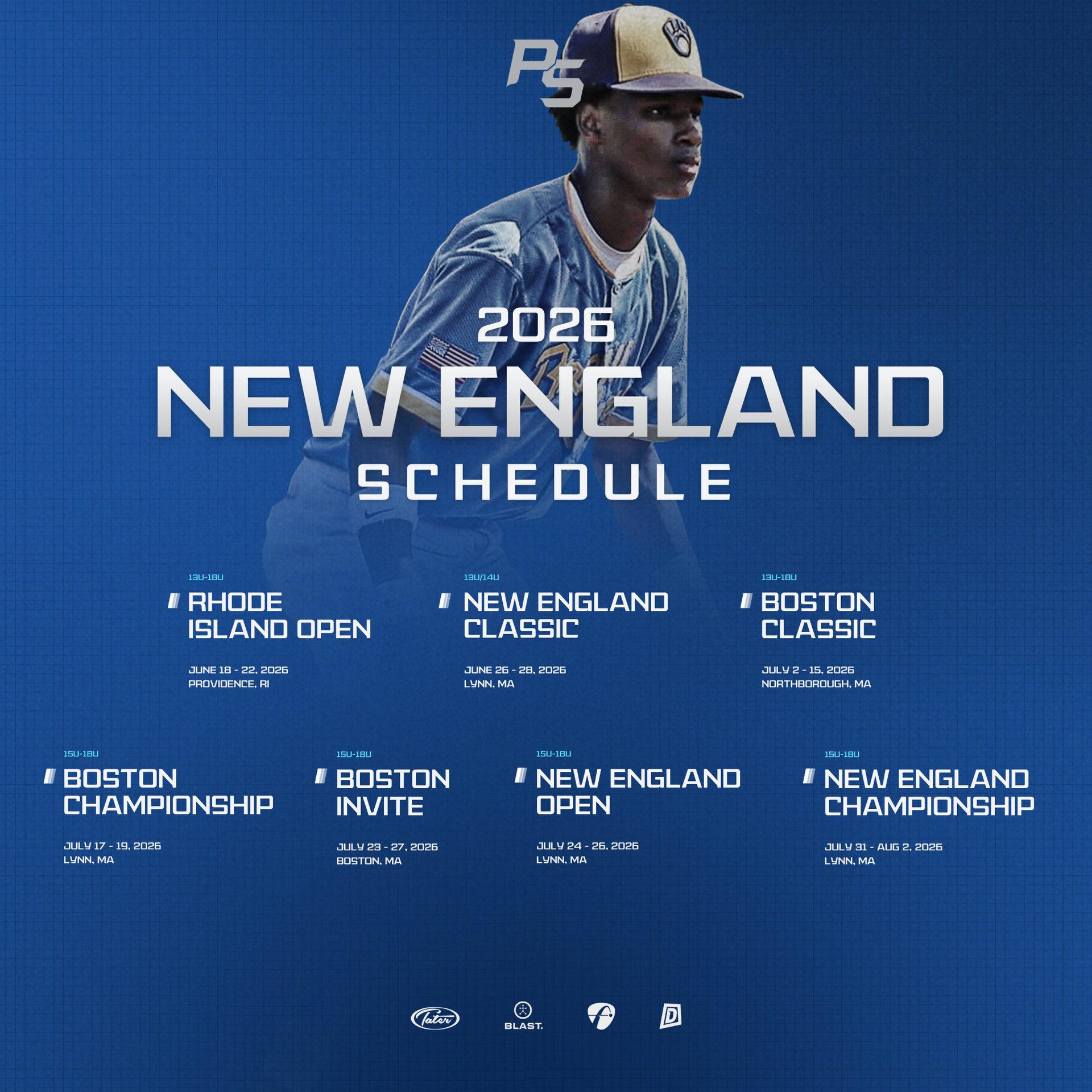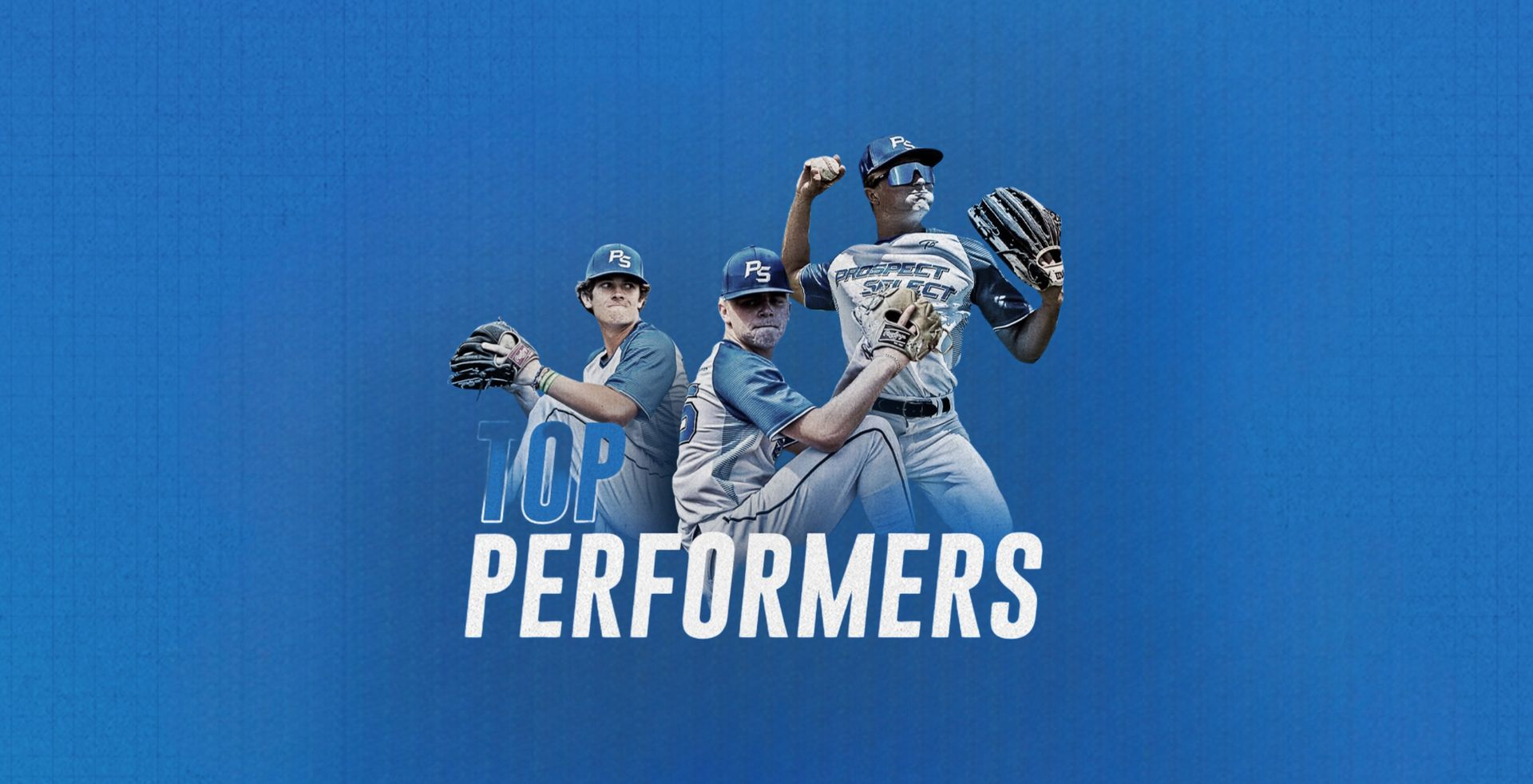Boston Classic - Data Scope
Interested in finding our more about your in game data, please visit your profile • Search for player profiles
**Not all fields will have in-game data**
Pitchers:
Caden Sivrich, Team All American 17U Red (2026, RHP)
Caden Sivrich brought elite velocity to the Boston Classic, leading the tournament with an average fastball velocity of 91.5 MPH, T94.2. The fastball paired the velocity with 15.5 inches of IVB and 8.9 inches of arm-side run, making it highly effective up in the zone. He also maintained exceptional extension at 6.13 feet, adding perceived velocity to an already explosive pitch. Sivrich’s secondary pitch was a slider at 83.0 MPH, thrown with above-average spin (2119 RPM) and subtle movement (-1.7 HB, 2.1 IVB). The pitch was effective, producing a 40% Whiff rate and 42.1% CSW%.
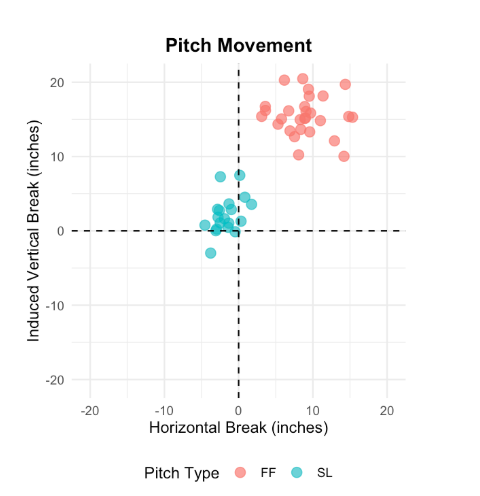
Gavin Chakar, CT Grind 2026 Carolina (2028, RHP)
Gavin Chakar turned in one of the most analytically impressive performances at the Boston Classic, featuring a high-spin, well-shaped fastball and two strong secondary offerings. His fastball averaged 88.6 MPH (T92.5) with 13.8 inches of IVB, 9.3 inches of arm-side run, and elite spin at 2437 RPM — one of the highest fastball spin rates in the event. He paired that with a sweeping slider at 77.2 MPH, averaging -6.9 inches of horizontal break and spinning at 2267 RPM, which generated a 57.1% Whiff rate and 34.6% CSW%. Chakar also mixed in a fading changeup at 80.6 MPH with 8.7 inches of arm-side movement and reduced IVB (3.2"), showing strong velocity separation and shape contrast. With a deep arsenal, high spin rates, and effective movement separation, Chakar proved to be one of the most complete arms at the event.
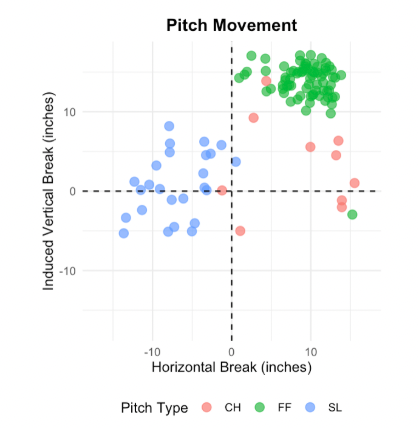
Lowell Golub, FTB Falcons Scout Team (2026, RHP)
Lowell Golub delivered a high swing and miss outing at the Boston Classic, backed by a fastball with standout shape and elite results. His fastball averaged 88.1 MPH (T89.5) with strong vertical break (14.7 IVB), moderate arm-side run, and an above-average spin rate of 2221 RPM. The pitch was dominant, earning a 54.5% Whiff rate and an exceptional 62.5% CSW% — among the highest fastball CSW marks in the event. He also flashed a slider at 79.5 MPH with -6.6 inches of horizontal break and spin at just over 2100 RPM, giving him a secondary look off the heater. Though used sparingly, the slider helped change eye levels and added depth to Golub’s profile as a fastball-dominant arm with true swing-and-miss traits.
Emerson Rhodes, Queen City Corndogs 2026 (2026, RHP)
Emerson Rhodes showed off a five-pitch mix at the Boston Classic, led by a well-shaped fastball that averaged 86.4 MPH (T87.9) with 17.3 inches of induced vertical break and over 10 inches of arm-side run. The pitch generated a 25% CSW%, providing the foundation for his arsenal. Rhodes’ top secondary was a curveball with steep vertical action, averaging -14.5 inches of IVB and spinning at 2037 RPM, used to change pace and keep hitters off balance. He also mixed in a fading changeup at 80.5 MPH with sub-1000 RPM spin, helping kill lift, and a short, sweeping slider with over -6.9 HB and 2100+ RPM. Though the cutter and slider were thrown in smaller samples, they added diversity and movement separation to a deep and projectable arsenal.
William Parker, On Deck O's 2026-Hill (2026, RHP)
William Parker turned in a strong showing at the Boston Classic with a well-rounded three-pitch mix led by an efficient fastball. His four-seamer averaged 86.9 MPH (T88.95) with standout movement at 17.7 inches of induced vertical break and over 8 inches of arm-side run, generating a 39.1% Whiff rate and a 34.1% CSW%. He paired it with a short, low-spin slider at 72.0 MPH (-4.9 IVB, -2.2 HB), offering shape separation and effective velocity differential.
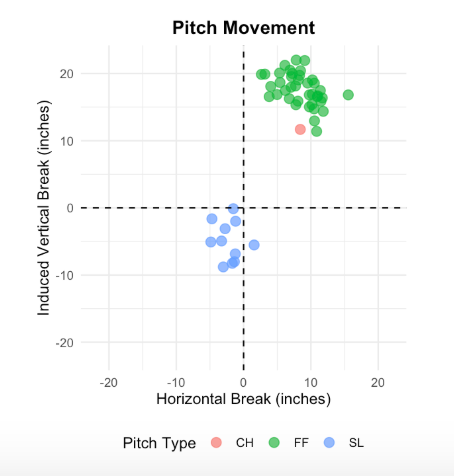
Cayden Vishnesky, Diamond Jacks 17U (2026, RHP)
Cayden Vishnesky brought a complete three-pitch arsenal to the Boston Classic, headlined by a high-carry fastball that averaged 85.7 MPH (T88.5) with 17.1 inches of induced vertical break and over 7.4 inches of arm-side run. The pitch generated a solid 34% CSW% with consistent in-zone effectiveness. His top secondary offering was a sweeping slider at 75.0 MPH, featuring nearly 9 inches of glove-side break and over 3 inches of lift — a deceptive shape that produced a 50% Whiff rate and 46.4% CSW%. Vishnesky also flashed a fading changeup at 79.0 MPH with over 8 inches of arm-side break and a big drop in spin (1217 RPM), resulting in a 66.7% Whiff rate and 50% CSW%.
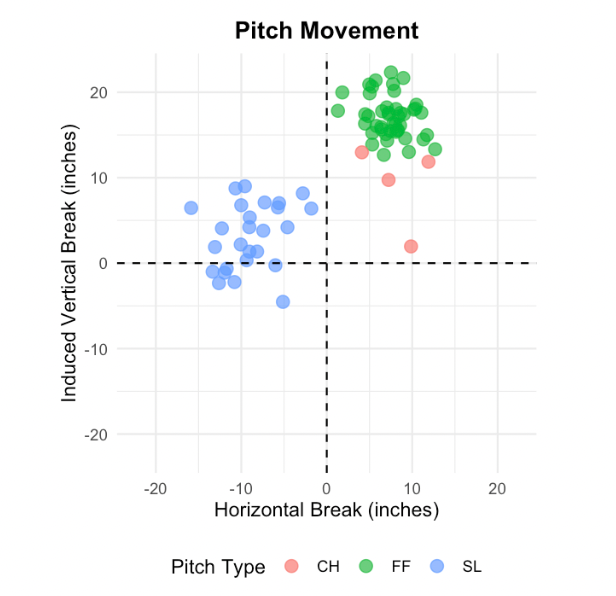
Charles Bernatchez, Academy of Baseball Canada (2026, RHP)
Charles Bernatchez flashed some of the sharpest breaking stuff at the Boston Classic, led by an elite slider that averaged 78.9 MPH with an exceptional movement profile — nearly 13 inches of glove-side break and -7.7 inches of vertical depth. The pitch spun at an incredible 2962 RPM, the highest spin rate in the event, generating a 60% Whiff rate and 40% CSW%. His fastball averaged 87.0 MPH (T88.9) with 10.5 IVB and 2402 RPM, serving as an effective setup pitch for his wipeout breaking ball. With advanced spin and lateral movement, Bernatchez’s slider proved to be one of the most unhittable pitches of the tournament.
Blake Butcher, US Elite Mid Atlantic - Scout 2026 (2026, LHP)
Blake Butcher brought one of the most unique pitch profiles to the Boston Classic, with extreme movement separation between his two pitches. His fastball sat 81.9 MPH (T83.9) with elite arm-side run, averaging nearly 15 inches of horizontal break — among the highest in the tournament — paired with modest ride (3.5 IVB). Butcher’s standout pitch, though, was a sweeping slider thrown at 69.2 MPH with over 17 inches of glove-side break and -6 inches of depth, spinning at an elite 2497 RPM. The pitch produced a 60% Whiff rate and 47% CSW%, making it one of the most effective breaking balls in the event. With near-mirror image movement in opposite directions, Butcher’s arsenal created high level deception. The pitch movement chart highlights the mirrored pitch shapes mentioned above:
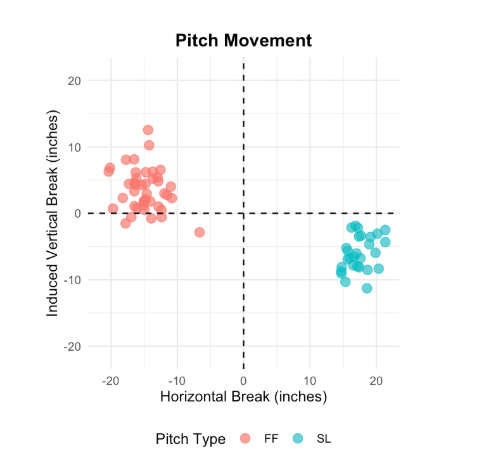
Adam Nasrallah, Academy of Baseball Canada (2026, LHP)
Adam Nasrallah turned in one of the most movement-heavy profiles at the Boston Classic, led by a fastball that averaged 83.5 MPH (T85.7) with an exceptional -17.8 inches of arm-side run and over 7 inches of induced vertical break. Despite the lower velocity band, the pitch missed bats at a 43.5% Whiff rate thanks to its late, running action. He also flashed a deceptive changeup at 77 MPH with a rare -15.3 inches of horizontal break and drastically reduced spin (991 RPM), creating strong velocity and shape separation. Nasrallah’s breaking ball, a short slider at 77.3 MPH and 2126 RPM, showed a more subtle shape but rounded out an arsenal full of movement.
Hawk Stickney, NEB Rays (2026, RHP)
Hawk Stickney showcased a well-rounded arsenal highlighted by a fastball averaging 85.7 MPH with a strong 12.1 inches of arm-side run and 13.2 inches of induced vertical break. The fastball generated an impressive 50% Whiff rate, demonstrating its effectiveness. Stickney’s slider stood out as a true swing-and-miss pitch, averaging just 71.6 MPH but featuring elite spin at 2400 RPM and sharp glove-side movement (-12.3 inches horizontal, -5.7 inches vertical), producing a remarkable 69.2% CSW rate. He also mixed in a changeup at 81.7 MPH with 8.3 inches of horizontal and 12 inches of vertical break, complementing his fastball-slider combo with solid velocity separation and movement.
Hitters:
Vinny Lombardo, CT Grind 2026 Carolina (2026, RHH)
Lombardo led the Boston Classic with an incredible 7 batted balls above 90 MPH, adding another 4 above 85 MPH, and two more above 80 MPH. His elite consistent contact resulted in 5 singles, 1 double, 2 triples, and a home run, showcasing rare power and speed. His Max Exit Velo of the event was 100.74 MPH.
- 100.74 EV, 18.34° LA, 306.56 ft
- 98.9 EV, 17.05° LA, 295.86 ft
- 92.28 EV, 38.74° LA, 307.51 ft
- 95.8 EV, 36.42° LA (Home Run)
- 96.93 EV, 11.76° LA, 204.29 ft
- 93.86 EV, 14.01° LA, 223 ft
- 95.34 EV, 10.42° LA, 207.65 ft
The below spray chart shows just some of Lombardo's contact throughout the weekend, highlighting his power up the middle of the field:
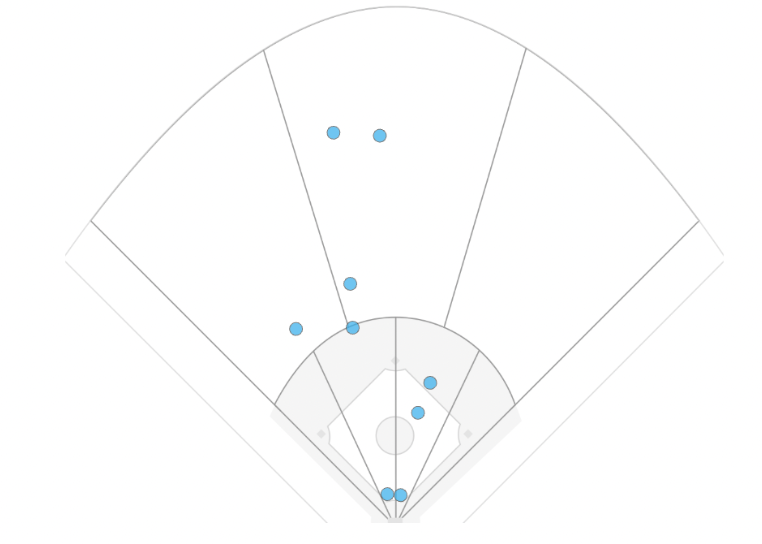
Shaun Flannery, CT Grind 2026 Carolina (2026, RHH)
Shaun Flannery was one of the most consistent power threats at the Boston Classic, registering four batted balls over 90 MPH and three more over 80 MPH. His max exit velocity topped out at an impressive 98.3 MPH, with a max carry of 344.6 feet, showcasing his ability to drive the ball deep. Flannery collected five hits in total, including a triple and a home run, while maintaining a solid contact profile with six batted balls above 85 MPH.
Notable Batted Balls:
- 98.31 EV, 27.21° LA, 344.56’
- 93.11 EV, 27.38° LA, 327.81’
- 90.04 EV, 62.32° LA
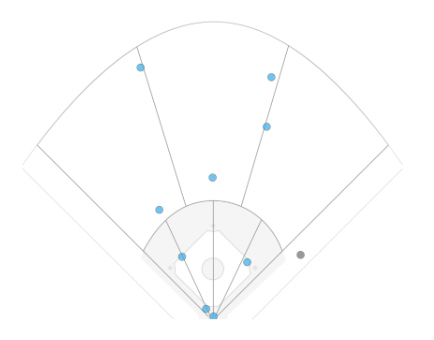
Zach Geertsma, CT Grind 2026 Carolina (2026, RHH)
Zach Geertsma turned in one of the more complete offensive showings at the Boston Classic, routinely making loud contact with five batted balls over 90 MPH, including a max exit velocity of 95.2 MPH. Geertsma collected a single, double, and triple during the tournament, all while posting six balls in play above 80 MPH — a strong indicator of consistent barrel contact.
Notable Batted Balls:
- 95.22 EV, 37.95° LA, 321.74’
- 93.18 EV, 32.91° LA, 316.53’
- 92.71 EV, 45.84° LA
Eli Livingston, US Elite Mid Atlantic - Scout 2026 (2026, LHH)
Eli Livingston showcased a combination of bat speed, raw power, and barrel consistency. The left-handed hitter posted his tournament max 99.2 MPH exit velocity, while generating eight batted balls above 80 MPH, including six above 85 and four north of 90.
Livingston’s loudest swing came on a 91.7 MPH home run, launched at a 32.8° angle and traveling 312 feet, but he also racked up a pair of doubles with exit velocities of 93.7 and 90.2 MPH, showing consistent ability to drive the ball in the air.
Notable Batted Balls:
- 99.15 EV, 9.63° LA, 164.8’
- 91.69 EV, 32.83° LA, 312.1’
- 93.65 EV, 18.12° LA, 266.9’
- 90.21 EV, 38.82° LA, 288.2’
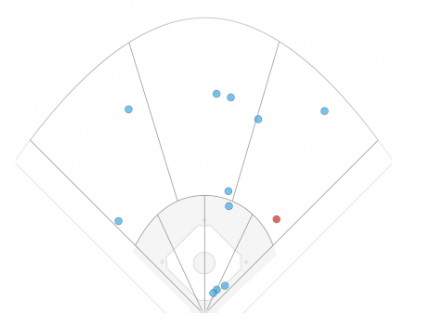
Jack Weierman, New England Ruffnecks 2026 (2026, RHH)
Jack Weierman brought impact to the Boston Classic with a pair of home runs, both hit with power. He posted a max exit velocity of 94.6 MPH and carried one out to 319 feet at a 34° launch angle. His other homer came off the bat at 92.5 MPH with a 26° launch angle, traveling just over 309 feet. He also squared up a changeup at 86.6 MPH and 29.7°, resulting in another deep drive.
Frankie Sommo, TKR Reds 2026 National (2026, RHH)
Frankie Sommo flashed strength and impact at the Boston Classic, highlighted by a 97.6 MPH home run that traveled 338 feet at a 32° launch angle. He collected four batted balls over 85 MPH—including two above 90. Sommo finished with two singles, two extra-base hits, and didn’t strike out in the event.
Notable Batted Balls:
- 97.64 EV, 32.36° LA, 338.26’
- 90.83 EV, 32.99° LA, 306.26’
- 85.2 EV, 32.17° LA, 316.80’
- 85.48 EV, 52.57° LA, 240.44’
Jose Padilla, CT Grind 2026 Carolina (2026, RHH)
While Padilla didn’t register any batted balls above 90 MPH, he stood out with 11 batted balls over 80 MPH, including eight above 85, showing highly impressive bat-to-ball skills. His top hit came on an 89.6 MPH ball that carried 305 feet to left-center. He also recorded a 292 ft fly ball at 86.35 MPH, and a 294-foot drive at 86.14 MPH. Padilla posted five singles, a double and a triple as well. Padilla’s ability to consistently lift and carry the ball without swing-and-miss (just one strikeout) stood out in his showing. The following spray chart shows impressive timing, as Padilla consistently made strong contact up the middle:
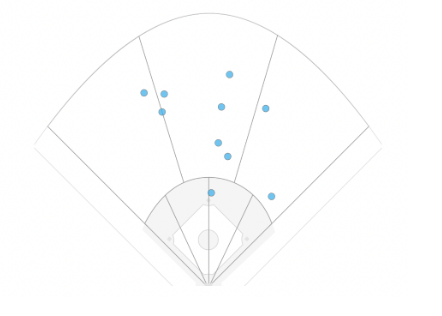
Jace Mataczynski, Minnesota Blizzard 2026 Blue (2026, RHH)
Jace Mataczynski put up one of the loudest single swings of the event with a 105.15 MPH blast that traveled 363 feet for a no-doubt home run. It was one of three batted balls he registered above 80 MPH, including two over 90.
He added three singles and did not strike out. Though the data set is smaller, the peak exit velocity and carry are among the highest in the event.
Leo Nockley, Northeast Pride 27 National (2027, RHH)
Leo Nockley put together a solid offensive showing, logging five batted balls over 80 MPH, including four above 90, with a max exit velocity of 96.74 MPH. He tallied three singles and made consistent contact without striking out.
Notable Batted Balls:
- 96.74 EV, 4.67° LA, 99.46 ft
- 92.1 EV, 19.46° LA, 260.29 ft
- 92.78 EV, 10.63° LA, 190.09 ft
Felix Gosselin, Academy of Baseball Canada (2025, LHH)
Felix Gosselin had four batted balls over 80 MPH, three of which cleared 90. His hardest swing came in at 101.55 MPH, one of the louder barrels in the event.
He drove a 92.77 MPH ball 300 feet at a 43° launch angle, and also notched a double and two singles while avoiding strikeouts.
Notable Batted Balls:
- 101.55 EV, 11.62° LA, 240.44 ft
- 92.77 EV, 43.38° LA, 300.21 ft
- 88.52 EV, 28.95° LA, 287.46 ft
